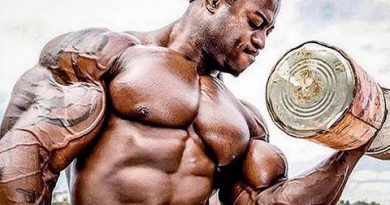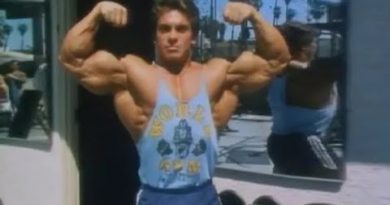Parallel Bar Dips – The Upper Body Squat
Bench press is usually called the king of upper body exercises, but it just isn’t true. Yes it is a big compound movement that works most of the upper body muscles yet it doesn’t really get the job done. Barbell squats are called the king of lower body exercises and this is true while leg press is an also ran. why? For the same reason bench press takes a back seat to parallel bar dips.
What makes parallel bar dips superior? First off parallel bar dips is a balancing exercise with only the hands to support you much like barbell squats with only your feet to support you.
Secondly the whole upper body must work together to stabilize itself as the arms go from straight arm to fully bent and back up again much like barbell squats except for the fact that barbell squats force the whole body into the movement, making it superior in that respect.
Thirdly the extreme range of motion possible with parallel bar dips cannot be matched by bench press, even the dumbbell version which carries a higher injury risk because of trying to control two heavy dumbbells as you begin to tire and start to lose control of two independent weights. Parallel dips mimic barbell squats in their vertical path, extreme extension resulting in the highest degree of stretch possible providing the greatest potential for complete development throughout the fullest range of motion. This is a very important aspect when choosing any exercise, the stretch being as important as the contraction.
Fourthly parallel bar dips are one of the few multi-joint exercises that retain tension on the muscles involved in the movement from extension to lockout, yes I said lockout. Like barbell squats at lockout the upper and lower arm bones lock like the upper and lower bones of the legs, but unlike the knee joint in which you can lockout and hold the weight, even resting for a few more reps, the muscles of the triceps cannot rest when the arms are locked out when doing parallel bar dips like they can when doing bench press.
Because of the body being suspended over the hands and the forward pull of this position the triceps must fight to hold the elbows locked. Also unlike bench press the pectorals are never allowed to rest, even at lockout they are contracting hard to hold you from falling forward. The front and side deltoid heads are working throughout the entire range and lockout. The amount of muscle fiber stimulation, continuous tension, time under tension, totality of muscle groups involved, extreme range, and extreme stretch make parallel bar dips the king of the upper body exercises, a worthy equal with barbell squats.
To break down the mechanics of parallel dips and compare it with barbell squats, the triceps act as the quadriceps, the biceps act as the hamstrings, the forearms act as the calves, the pectorals act as the buttocks, the deltoids act as the hips, the trapezius act as the lower back, the abdominals and spinal erectors act as stabilizers to keep the body still and to hold position and the latissimus act as a solid base for the upper arms to push off, working with the triceps to move the arms to a straight arm position and helping the triceps to guide the body into the bottom position, acting like a spring being tightened.
The trapezius, latissimus, and triceps work together to get the body out of the hole and as the body ascends the deltoids and pectorals take on bigger roles, the pectorals and trapezius working in unison, the latissimus bracing the deltoids and triceps as they move to lockout. A truly powerful movement.
The strength potential possible with parallel bar dips is considerable, I myself have used well over one hundred additional pounds tied to me for reps. My brother on the higher end of possibility has parallel bar dipped for five full range reps with front delts touching hands at the bottom to straight arm lockout with two hundred and five pounds of additional weight tied to him at a body weight of one hundred and ninety pounds, quite a sight to behold.
As with any exercise good form is vital to avoid injury and insure complete development, especially with an exercise like parallel bar dips. Trust me, you can’t fake heavy weighted dips, they will kick your ass and quickly show you who’s boss. This is a true power exercise and one that must be respected, you must have total focus the whole time, there is no room for daydreaming or sloppy form, dropping to the bottom position and if you are going to do partial reps, staying close to the top of the movement so you can handle some big weights, you are wasting your time and have missed the whole point of doing this movement.
Lets quickly go over the execution of the movement, starting with arms locked, supporting your weight, with your hands grasping two bars set about two feet apart and at a height that your bent knees won’t make contact with the floor at the bottom of the movement, totally focus on remaining still and lowering yourself by bending your arms in a slow controlled manner, keeping them close to your sides, feeling your muscles tighten like a spring until you come smoothly to a dead stop with your hands in contact with your front delts with your arms bent as far as they can bend, feeling the stretch in your pectorals then remaining tight begin to push yourself back up, not bouncing out of the bottom and keeping your body as still as possible to straight arm lockout.
Do not let the elbows snap shut at lockout or drop out of lockout on the downward part of the movement, if you are doing this you are using too much additional weight and do not have control of the weight.
Also you may have heard there are two ways to do parallel bar dips, leaning way forward for the pectorals and holding the body as vertical as possible for the triceps. It is best to do parallel bar dips in natural neutral position that feels comfortable and is easy to maintain.
Doing parallel bar dips with an excessive forward lean places negative stress on the elbows and front delts as well as the rotor cuffs.
Doing parallel bar dips with a straight up and down position is hard to maintain as the reps get harder as well as the fact that the muscles have enough to deal with in keeping you balanced over your hands while you are in motion.
If you want to target triceps more than pectorals, bench dips are a far superior choice as they actually place your upper body ahead of your arms, shift more stress to your triceps, make it effortless to maintain position so you can focus all your attention on the tricep action while still getting the benefits of extreme range of motion, superior tricep and pectoral stretch improved shoulder joint mobility beyond even regular parallel bar dips, and continuous tension, though making lockout easier to hold thus the need not to linger at lockout.
Parallel bar dips fit nicely anywhere in a routine, used at the beginning you could do a lot worse that parallel bar dips and cross bench dumbbell pullovers in building size and power in your pectorals, deltoids and triceps in a simple basic mass format.
Done at the end of the chest portion of your workout, parallel bar dips can push your chest and deltoids hard when employing more isolated exercises beforehand.
Done at the end of the triceps portion of your workout, your chest, shoulders, lats, and traps can push your triceps to greater size and development.
If I could only do two exercises for the upper body I would choose shoulder width under grip chins and parallel bar dips, the upper body squat.
Parallel Bar Dips – The Upper Body Squat by Steve Sawyer




